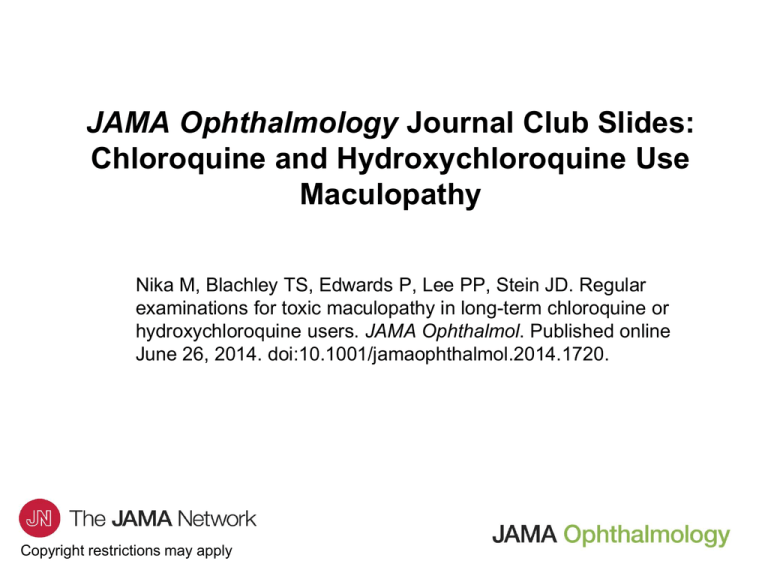
JAMA Ophthalmology Journal Club Slides:
Chloroquine and Hydroxychloroquine Use
Maculopathy
Nika M, Blachley TS, Edwards P, Lee PP, Stein JD. Regular
examinations for toxic maculopathy in long-term chloroquine or
hydroxychloroquine users. JAMA Ophthalmol. Published online
June 26, 2014. doi:10.1001/jamaophthalmol.2014.1720.
Copyright restrictions may apply
Introduction
•
Chloroquine (CQ) and hydroxychloroquine sulfate (HCQ) are medications
commonly used to treat rheumatoid arthritis (RA), systemic lupus
erythematosus (SLE), and other rheumatological conditions. A known
adverse effect associated with long-term use of these medications is vision
loss resulting from irreversible retinal toxic effects.
•
Guidelines put forth by the American Academy of Ophthalmology
recommend screening patients who have long-term exposure to these
medications to check for signs of retinopathy. Screening tests include a
dilated eye examination, perimetry, Amsler grid testing, fundus photography,
fluorescein angiography, multifocal electroretinography, and optical
coherence tomography.
•
Objective: To determine whether enrollees in a large US managed care
network with RA or SLE taking CQ or HCQ are regularly visiting eye care
providers and being screened for maculopathy.
Copyright restrictions may apply
•
•
Methods
Data Source
– Clinformatics database: health care claims database of beneficiaries in a
large managed care network who had any form of eye care from 2001-2012.
– Database contains:
• Claims for all ocular and nonocular medical conditions.
• International Classification of Diseases, Ninth Revision, Clinical
Modification diagnosis and Current Procedural Terminology billing codes.
• Sociodemographic information for each enrollee.
• Records of all outpatient medications prescribed.
– Data were linked by a unique identifier, allowing enrollees to be followed up
longitudinally over time.
Sample Selection
– All persons diagnosed as having RA or SLE who were continuously enrolled
in the medical plan for ≥5 years after their first RA or SLE diagnosis were
identified. Those with noncontinuous enrollment were excluded, as were
enrollees with <5 years of follow-up after first RA or SLE diagnosis.
Copyright restrictions may apply
Methods
•
•
•
•
Quantifying CQ or HCQ use: none, >0 to <6 months, 6-12 months, 12-24
months, 24-48 months, ≥48 months, and >5 years.
Identifying persons at highest risk for maculopathy: patients with >1 year of CQ
or HCQ use with concomitant renal or hepatic disease, retinal disease, or ≥60
years of age.
Identifying persons with greatest use of CQ or HCQ: patients with use of CQ or
HCQ for ≥4 years of the 5-year study period.
Multivariable logistic regression:
– Determined factors affecting the odds of visiting an eye care provider
regularly (eye examinations in ≥3 of the 5 years) among those at highest risk
for maculopathy, among the greatest users of CQ or HCQ, and overall.
– CQ or HCQ use was the key predictor of interest in the model.
– Other covariates in models: age, sex, race, education, income, diabetes,
hypertension, depression, patients whose SLE or RA is managed by a
rheumatologist, and long-term oral steroid use.
Copyright restrictions may apply
Results
•
•
•
•
18 051 Total eligible enrollees.
Medication use:
– 6339 enrollees (35.1%) had any CQ or HCQ use during the 5 years.
– 8% of enrollees were prescribed CQ or HCQ for ≥4 years
Visits to eye care providers:
– 77% of enrollees had ≥1 visit to an eye care provider in 5-year study period.
– Highest CQ or HCQ users: 66%-72% visited an eye care provider ≥1 time in
a given year; 8% had no visits to eye care providers during the 5-year study
period.
– Highest risk for maculopathy: 68%-73% visited an eye care provider ≥1 time
in a given year; 6% had no visits to eye care providers during the 5-year
study period.
Diagnostic testing for maculopathy
– Highest CQ or HCQ users: 64% had ≥1 diagnostic test during the 5 years.
– Highest maculopathy risk: 66% had ≥1 diagnostic test during the 5 years.
– Few underwent diagnostic testing annually.
Copyright restrictions may apply
Results
Eye Care Visits and Diagnostic Testing Based on the
Amount of CQ or HCQ Use
Copyright restrictions may apply
Results
Eye Care Visits and Diagnostic Testing Among Low-Risk and High-Risk Patients
Copyright restrictions may apply
Results
Odds of Seeking Regular Eye Care in All Patients
Copyright restrictions may apply
Results
Odds of Seeking Regular Eye Care in High-Risk Patients
Copyright restrictions may apply
Comment
•
•
Key Findings
– Despite all of the enrollees possessing health insurance, a large number
of persons with long-term CQ or HCQ therapy are not undergoing annual
eye examinations or screening tests as recommended by expert
guidelines.
– Among those enrollees at high risk for maculopathy, 6% had no eye care
visits during the entire 5 years, only 57% had visits to eye care providers
in ≥4 of the 5 years, and 34% had no record of any diagnostic testing
(visual field, optical coherence tomography, etc) during the 5 years.
– Odds of receiving regular eye care are statistically significantly greater for
those taking CQ or HCQ relative to others.
Factors associated with increased odds of receiving regular eye care:
– Older age, female sex, education higher than high school level, endorgan damage from diabetes or hypertension, and patients whose RA or
SLE was being managed by a rheumatologist.
Copyright restrictions may apply
Comment
•
Study Strengths: Large sample size, nationwide cohort with good geographic
diversity, longitudinal data (not cross-sectional); all enrollees have medical
insurance and thus access to eye care providers, and testing should not be an
issue; diversity of health care providers practicing in an array of settings.
•
Study Limitations: Inability to link eye care visits and testing captured in the
database to outcomes (eg, loss of best-corrected visual acuity); data were
extracted from billing records (inability to access clinical records); limited ability to
identify high-risk patients based on billing codes alone; inability to quantify CQ or
HCQ use before plan entry or cumulative exposure to these medications (only
exposure during time in plan).
•
Conclusions: Many CQ or HCQ users, including patients at high risk for retinal
toxic effects and long-term users over multiple years, are not undergoing regular
visits to eye care providers and diagnostic testing to check for maculopathy, as
recommended by the American Academy of Ophthalmology. Future studies will
hopefully identify reasons for nonadherence to the recommendations and ways of
improving adherence.
Copyright restrictions may apply
Contact Information
•
If you have questions, please contact the corresponding author:
– Joshua D. Stein, MD, MS, W. K. Kellogg Eye Center, Department of
Ophthalmology and Visual Sciences, University of Michigan, 1000 Wall
St, Ann Arbor, MI 48105 (jdstein@med.umich.edu).
Funding/Support
•
This study was supported by K23 Mentored Clinician Scientist Award
1K23EY019511 from the National Eye Institute (Dr Stein), by the Blue Cross
Blue Shield of Michigan Foundation (Dr Stein), and by a Physician Scientist
Award from Research to Prevent Blindness (Dr Stein).
Conflict of Interest Disclosures
•
None reported.
Copyright restrictions may apply







